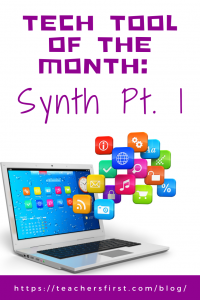Synth is a very simple podcasting tool. The site allows you to create audio recordings up to 256 seconds long, which reminded me of tweets on Twitter, but in audio format, so rather than 256 characters in length, they are 256 seconds long. Need more time? Synth also allows you to link together several Synths to create a longer podcast. Other helpful features are the ability to add transcripts of your recordings and use a webcam. This is great for your students who may not learn by listening, but need to see the text. Students can collaborate and “link” various Synths by inviting people to participate by sharing the URL.
Applying the Triple E Framework
The Triple E Framework, created by Dr. Liz Kolb, is built on the belief that “effective technology integration begins with good instructional strategies and not fancy tools.” Dr. Kolb wrote a book on the topic: Learning First, Technology Second. Technology can be used to Engage in learning goals, Enhance learning goals, or Extend learning goals. We can use this framework to decipher why we are using specific tools in the classroom. Here is a rubric we can use to evaluate Synth (and any others) using the Triple E Framework. Use the rubric as you decide if a tool is a good fit with your learning goals and why you should (or shouldn’t) use the technology tool in the lesson.
- Engage in learning goals: The students are more focused on the task because Synth is allowing them to create a podcast that represents the content learning goals (for example, learning the battles of the Civil War). Synth has minimal distractions (or bells and whistles). There are no games, badges, or extras to distract from the process of learning.
- Enhance learning goals: By using Synth to create a podcast, students are able to share concepts, questions, and information. Podcasts allow students to assess their comprehension and to demonstrate a more sophisticated understanding of the topic by creating their own original work. They are using higher-order thinking skills to organize their thoughts and words for the podcast. Also included is creativity as students have the option to include opening sounds, transitions, and more.
- Extend learning goals: Dr. Kolb describes extended learning as an opportunity for students to connect and collaborate outside of the regular school day. It is also described as a bridge between the school day and real-life experiences. The third point of extending learning is allowing students to use everyday skills. This tool does allow students to connect and collaborate by listening to others’ Synths and even linking their own Synths to other students’ projects. Students could create an original Synth asking a question or requesting feedback. Other students could collaborate by adding their own Synth to the podcast. Creating podcasts allows students to build skills that they will use in their everyday lives outside of the classroom environment. Students are learning speaking skills, how to construct their thoughts, and how to use digital tools (such as Synth). These skills will help students be successful in completing future assignments that require speaking virtually or publicly. It will also help to prepare students for learning beyond the classroom, as they construct their thoughts and apply the use of digital tools and speaking skills at work and in their personal life.
SAMR Connection
 The SAMR Model, by Dr. Ruben Puentedura, suggests that technology implementation has four levels. We can use this model as a guideline to analyze how we are incorporating technology tools in the classroom. Depending on how you are using Synth, it could be connected to various levels on the SAMR Model.
The SAMR Model, by Dr. Ruben Puentedura, suggests that technology implementation has four levels. We can use this model as a guideline to analyze how we are incorporating technology tools in the classroom. Depending on how you are using Synth, it could be connected to various levels on the SAMR Model.
- Substitution: If students are provided with a link to a direct question and must provide a response, they are simply substituting writing and drawing on paper, and are now using their voice to answer the question.
- Augmentation: Synth could be at the Augmentation level since the audio (music) tools available are not something that students can typically add to the written paper and add a flair of creativity to the podcasts.
- Modification: To reach the level of Modification, students could add audio to tasks that were traditionally written (such as adding audio to a website, blog, slideshow, and others). From there, allow students to create their own podcasts and seek (and give) peer feedback.
- Redefinition: The highest level of SAMR could be reached by adding the use of the video option. The teacher could then share the Synth on the class website for students (and families) to view. Redefinition can be reached by allowing the use of both audio and video. Plus, students can create their own original podcasts (including video). Students can also be given the option to collaborate with a partner or small group to design their podcast(s).
Don’t miss Part 2 of the Tech Tool of the Month: Synth. We will discuss how to use the tool and provide classroom use ideas. In the meantime, let us know in the comment section below how you have used Synth in your education setting.


One thought on “Tech Tool of the Month: Synth Part 1”